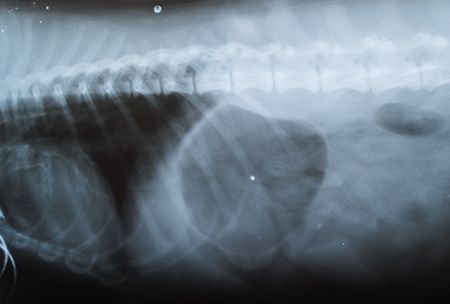Picture this! 4 veterinary experts' imaging tips
Here's help from some of our favorite veterinary radiologists for zeroing in on important imaging findings.

(rarinleerapun/AdobeStock)
To enhance the chances you'll get diagnostic answers from your radiographs, we rounded up some tops tips from a series of exceptional veterinary radiologists who have taught at Fetch dvm360 conference.
Get those radiographs, and don't forget this view …
-Maria Evola, DVM, MPH, DACVR, North Carolina State University
If I had one tip to give for the acute abdomen or a vomiting patient it would be to take a left lateral projection. I really love left lateral projections because they put gas (which is a naturally occurring contrast medium that's already present in the stomach) in the pylorus, the pyloric antrum and sometimes the proximal duodenum as well. It can really help to highlight foreign material, especially in the pyloric antrum, by surrounding that foreign material with gas. It's a really good way, before we do anything else, of just ensuring that the stomach looks very normal. So if I have a right lateral projection and an orthogonal view of the patient who is vomiting, one of the first things I'll recommend is obtaining a left lateral projection and just making sure that there's not something that we can see already without doing any other advanced imaging.
Hear it all right from Dr. Evola here.
You got the radiographs but you're a little unsure. Should you consult a specialist? Yes, but don't forget this …
-Rachel Pollard, DVM, PhD, DACVR, University of California-Davis
I think that telemedicine is taking off in all aspects of veterinary practice. But in imaging it really is changing the way that veterinarians can access specialists in a useful way. So I am very excited about the trend toward more telemedicine. If I could give a pointer to people who are sending cases in to radiologists it would be to please fill out the history yourself. Don't ask someone who is unfamiliar with the case to provide the background data. Because a pertinent history can help a radiologist prioritize differentials for you in a much more useful way, and that's going to give you the best patient care possible.
Hear it all right from Dr. Pollard here.
About those notations in your patient history …
-Eli Cohen, DVM, DACVR, North Carolina State University
Speaking from a teleradiologist's or a support service's perspective, the important thing to know is why you're doing the radiographs. In other words, taking 20 radiographs of the entire musculoskeletal system without localizing the lesion inherently decreases the predictive value of that test. So clinical history is vital for an expert to pull upon. And we know from eye tracking studies that it will physically change the way your eye searches the image, depending on what you're looking for. Being told that here is a radiograph, say of a limb with no known lameness, can physically change the way you search that limb, as opposed to saying there's a lameness centered at the scapulohumoral joint. It will change how much we scrutinize, how much time we scrutinize and whether we recommend additional tests, which is not solely based on the imaging but is as much based on the clinical history and what we're looking for. So it's really, really important to provide that information, whether it's to yourself, your colleague or a radiologist, so they can do their best job and achieve the best outcome for the patient.
Hear it all right from Dr. Cohen here.
The radiograph is all scrutinized and it didn't show anything. What do you tell the client? “I have great news!”
-Betsy Charles, DVM, MA
What I often hear from veterinarians or when we're in the classroom and talking to students is, “Ah, I don't see anything on the radiograph.” And we don't communicate that that's actually a good thing that we don't see any evidence of a foreign body. We don't see any evidence that would explain what is causing this patient's vomiting or diarrhea or whatever the clinical presenting signs might be. And we have to go that next step and say, “That's great news.” And then we need more information. Saying, “We didn't find anything” communicates that we did something that maybe we didn't need to do. I would rather you say, “This gave us really great information because we know that we can rule out some things. Can't rule out everything. But we can minimize some of our differentials based on this diagnostic exam.”
Hear it all right from Dr. Charles here.
Veterinary scene down under: Australia welcomes first mobile CT scanner, and more news
June 25th 2024Updates on the launch of the first mobile CT scanner available for Australian pets; and learn about the innovative device which simplifies placement of urinary catheters in female dogs
Read More